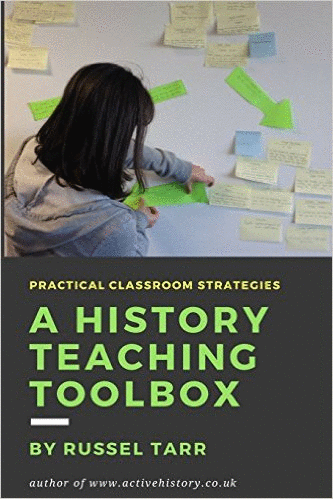 This activity for IB History forms one part of a detailed unit of study on Marxism and Capitalism that can be found in full here.
This activity for IB History forms one part of a detailed unit of study on Marxism and Capitalism that can be found in full here.
Background
- This roleplay simulation forms part of an in-depth study of Tsarist Russia under Alexander II, Alexander III, Nicholas II, and the 1917 Revolutions and Marxist ideology. All of these detailed worksheets and interactivities can be found at www.activehistory.co.uk .
- The roleplay is deliberately engineered to demonstrate the Marxist conception of how capitalism and the free markets operate.
- In subsequent lessons students produce a critique of Marxism, produce a defence of capitalism and thereby form their own independent judgment.
Overview
- The ONLY objective of each player in this game is to make as much money as possible.
- Each student starts with 50 coins (these will be tracked in an Excel spreadsheet).
- At the end of the game, coins can be cashed in against chocolate.
- Extra coins can be earned over several rounds of the game (by converting cash to raw materials, raw materials to goods, and goods back into cash at profit).
- Any goods still stockpiled at the end of the game are effectively wasted.
Round 1: To illustrate Marx’s view that "All Property is Theft"
• This round will illustrate Marx’s view that free market capitalism benefits the most ruthless and aggressive members of society (a view also posited in John Ronson’s The Psychopath Test).
a. Split or Steal?
- Students are arranged into pairs, and each pair is given 100 coins (if there is an odd number of people in the class then the teacher can make up the difference).
- Each pair pools their coins, then plays a game of 'split or steal' according to the following rules:
- The pair can talk to each other for a couple of minutes discussing a strategy.
- Each pair will be given a slip of paper on which they will secretly write ‘split’ or ‘steal’.
- However, neither one of them is obliged to honour their promise.
- The teacher will take both slips from the students after they have written ‘split’ or ‘steal’.
- These will be read out to the class.
- If both students chose ‘split’ then the money gets split between them.
- If one students chose ‘steal’ and the other ‘split’ the money goes to the ‘stealer’.
- If both students chose ‘steal’ they neither one gets any coins at all.
- Remember that the objective is to make more money, not to earn trust or ‘do the right thing’.
- Any students left with one or no coins after this process should sit down at the side of the room. They become the proletariat.
- Repeat this process (pairing up people who have the same amount of coins as far as is possible) until about a third of the people in the class have become members of the proletariat.
After this round is complete, show the students this excellent clip of the "Split or Steal" game being played as a quiz show. It's great!
 b. Arm Wrestling
b. Arm Wrestling
- Each student must challenge one other student in the room to an arm wrestle: the winner will take 20 coins from the loser.
- Any students left with fewer than 20 coins after this process (i.e. not enough money to purchase raw materials, see next stage) should sit down at the side of the room. They become the proletariat.
• Repeat this process until about two thirds of the people in the class have become members of the proletariat.
Round 2: Bourgeoisie and Proletarians – the creation of wage slaves
• We are now in a state where most of the class are proletarians, and a few are aspiring capitalists.
• Explain to students that this illustrates Marx’s view that the capitalist system favours the most aggressive and selfish elements in society.
ADVANCE WARNING TO STUDENTSWarn students of the ‘cost of living’ rule that will be applied at the end of this round (see below).
This will impress upon them the importance of finding employment – at almost any cost.
• In this phase, the capitalists will seek to turn their cash into profit by investing in raw materials, employing workers, producing goods, and selling these at a profit.
• Some of these profits will be paid to the workers in wages; but the owner should aim to keep as much of the profit for him/herself as possible. The workers are under a great deal of pressure to accept offers of employment.
Rules
For people with 20 coins or more:
- You can buy as many units of raw material as you wish (each one costs 20 coins). This is a piece of paper which needs to be torn into 8 neat squares (no tools allowed).
- Each square can be sold for 5 coins (a nice profit!)
- You cannot work on the material yourself: you must employ proletarians to do so.
For people with less than 20 coins:
- You form part of the potential workforce.
- You need to decide on how many coins you will agree to work for in return for.
- Bear in mind that those workers agreeing to work at the cheapest wage are most guaranteed to get a job. It is in your interests not to ‘price yourself out of the market’.
Procedure
- Each capitalist must decide how many units of raw material to buy.
- Each proletarian must decide how many coins they are willing to work for.
- The capitalists collect their raw material and pay for it in cash.
- The proletarians each state their rate of wages.
• The capitalists will then take it in turns to employ one worker each (if they wish to do so). Repeat this process until the capitalists have employed as many people as they wish. Obviously the cheapest workers will be employed first, and those left without work will earn nothing whatsoever. So during this process give workers the chance to change their wage rates to a more competitive level (thereby driving down wage rates).
• Each ‘factory’ is then given 2 minutes to produce as many goods as possible. Remember that only proletarians can produce goods, and that the best quality goods will sell easiest – so it’s important for the capitalists to monitor the quality of work (although they are under no obligation to pay the worker if their work is defective).
• The produce is brought to the teacher, who purchases the best quality goods at 30 coins per item. Make a point of not buying everything. Surplus goods can be kept ‘in stock’ and put up for sale in subsequent rounds (this will encourage factories to ‘lay off’ workers in times of economic downturn).
• The capitalists then have to pay their worker(s) at the rate agreed.
• Record in the Excel spreadsheet the coins now owned by each person.
COST OF LIVING At this point, every person will now hand over ten coins to the teacher to represent the general cost of living.
Any person without coins who is still unemployed will be considered to have starved to death. Their game is over and they will need to be directed to another task (e.g. researching criticisms of the Marxist analysis).
 Subsequent Rounds
Subsequent Rounds
The teacher will repeat Round 2 several times, but with new ‘twists’ to highlight other injustices, e.g.:
- Offer a pair of scissors (and / or a ruler) for auction. Make it plain that this will make cutting easier, and definitely increase profits (represents mechanisation / production lines). Auction them to the highest bidder, allowing individual capitalists to form mergers if they wish to raise the necessary capital. Ensure that goods produced by these goods are always purchased first. The result will be to drive out the smaller artisans and put control in the hands of large corporations.
- Announce a glut in the market (either before the production round begins, or at the point the goods are brought to the teacher for sale). This means that the teacher will buy fewer goods overall, be much more demanding in the quality of goods expected, and / or the price of goods purchased will be lower than the 30 coins usually on offer. Capitalists will then be inclined to purchase fewer raw materials, stockpile ‘unsold’ goods and offer less employment in the next round; workers might then have to discuss a strategy for survival (revolution?)
- Owners can confer and discuss a wage strategy to keep wages down (cartel)
- Owners can confer and decide whether to join together (monopoly)
- The teacher can offer a credit system at a low rate of interest (to encourage entrepreneurialism).
- Workers can form a 'trade union' with a nominated representative to negotiate with the owners.
- Workers can pool their resources to create a 'strike fund' that all members can draw from.
End Result
• Coins should be exchanged for chocolates.
• Discussion Points follow:
- Why did some people become bourgeoisie, and other people became proletarians?
- A capitalist would say that the free market rewards hard work and punishes the lazy. What would a Marxist say to this?
- What new rules could we have added to ensure a fairer distribution of resources?
This roleplay is very much a work in progress. If you have any comments or suggestions or feedback you can contact me through the ActiveHistory Contact Form or on Twitter (@russeltarr).

© 1998-2026 Russel Tarr, ActiveHistory.co.uk Limited (Reg. 6111680)
1 Torrin Drive, Shrewsbury, Shropshire, SY3 6AW, England
Privacy Policy | Contact






